There is so much to like about Scotland’s continual transformation into genuine Six Nations contenders but even with rivals Wales on the ropes last weekend, they could not close the deal. A slew of opportunities went begging and despite building a 17-3 lead, Scotland somehow found themselves staring down the barrel of a 20-17 deficit late in the match.
A Stuart Hogg try nearly salvaged the win before Wales winger Louis Rees-Zammit stole the show and Six Nations supremacy with it.
Scotland’s attack showed some glorious inventiveness with smart attacking kicks that resulted in two tries to open up the big lead, but when they get their prime opportunities they can’t seem to take them.
With fullback Hogg in a rich vein of form, this Scotland side has all the makings of an unstoppable unit but the team seems to become its own worst enemy, not knowing where their strengths lie.
Against England, rookie inside centre Cameron Redpath shone brightly while recently qualified Duhan van der Merwe has bolstered the firepower at the Scots’ disposal with two blockbusting displays over the first two weeks. Darcy Graham’s slippery evasiveness on the edge adds another dimension.
There are some serious threats in the Scotland backline that any opposition would struggle to contain, but they aren’t being handed the opportunities they need to prosper.
Every time Scotland enter the opposition 22, the gears grind to a halt and the attack enters an anaemic state where play slows down and a turnover seem to be the inevitable outcome.
There are mismatches to be exploited, odds forming in Scotland’s favour, yet they persist with a dull insistence of one-out carries that ultimately lets the opposition off the hook. The launch plays are often multi-phase patterns that rely on forward carries when the opportunity to strike already exists somewhere further out.
Against England, Redpath blazed a trail over the gain line with sharp running, piercing deep blows into the opposition defensive line on first phase. Without him against Wales, it was van der Merwe and Graham doing the exact same thing.
Scotland have been able to generate amazing first phase momentum that many sides would currently be envious of. It is incredible just how successful they have been at winning the gain line with their stable of first-phase plays.
With their first red zone attacking platform of the match, Scotland ran a clever first phase play to immediately bring left wing van der Merwe into the game. A clever formation originally concealed the winger, who took the ball from halfback Ali Price while running from depth in between his flyhalf and inside centre.


The line of van der Merwe is quite wide, bee-lining towards the Welsh midfield.
A strong angled carry always works in the attacking team’s favour as it forces the opposition loose forwards to work even harder to fold over as the breakdown is set wider. As van der Merwe hits the ground, Justin Tipuric is a long way from the forming ruck.
If the carrier can also take two or three defenders to the ground, the defensive line on the far side becomes severely compromised.
On this occasion, van der Merwe shakes off centre Owen Watkin, while wing Liam Williams decides to compete for the ball to slow down the play. This means Wales’ two most important edge defenders are out of the line for the next phase and the loose forwards haven’t folded yet due to the wide ruck.

This situation is begging for quick distribution to strike the same way. Finn Russell can link with Hogg fewer than 10 metres from the tryline against a disorganised defence. Instead, Scotland call a multi-phase pattern that requires a carry on the second phase.
Halfback Price (9) has to wait for his runners to come around the corner, giving Wales the chance to re-group. He has his hands on the ball while crucial time passes.
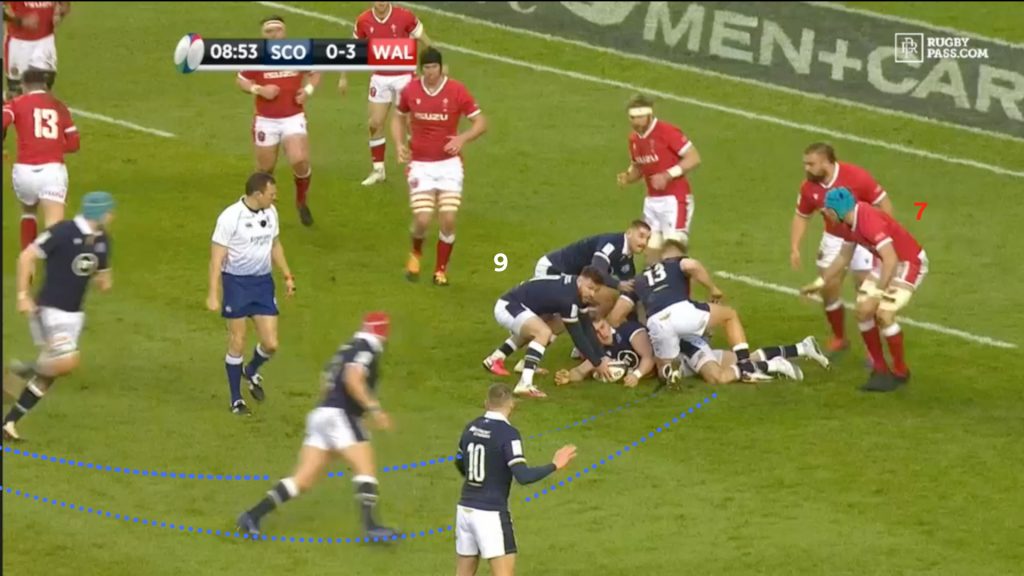
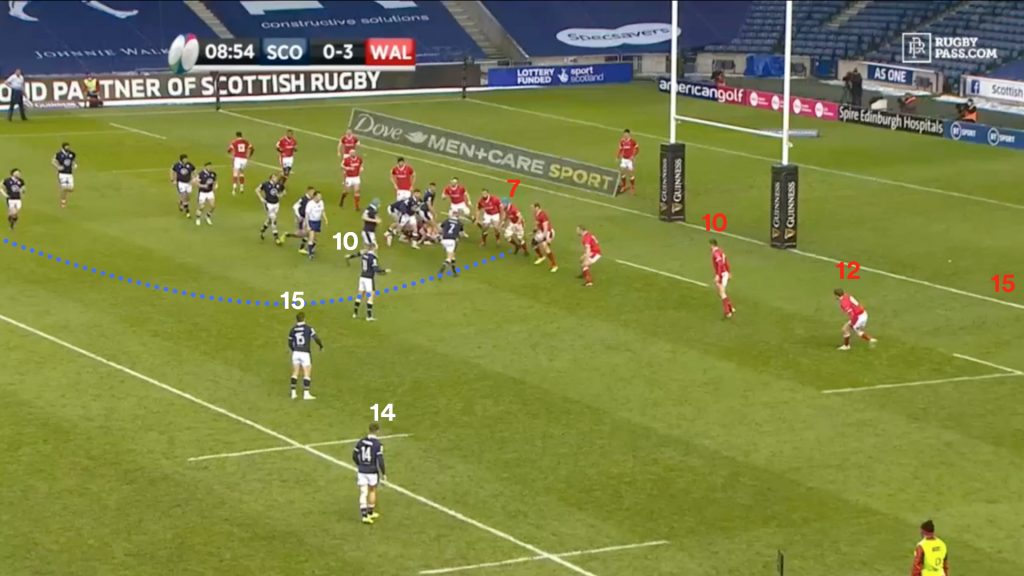
After an almost five second pause, hooker George Turner tries to hammer into a well-resourced Welsh wall close to the ruck and is stopped in his tracks.
Out wide we see flyhalf Dan Biggar and inside centre Nick Tompkins stationed on Wales’ edge, with fullback Leigh Halfpenny out of picture in the backfield.
Had the ball been delivered quickly to Russell, Scotland would have handed their in-form captain a chance to attack from short range.
Hogg is going through a purple patch right now and is perhaps on track to earn his third Six Nations Player of the Championship award.
The odds of him getting around Tompkins on the outside and either scoring himself, or drawing Halfpenny in and playing Darcy Graham over untouched, are much higher than having the forwards bury over from close range.

They had all the momentum of first phase from the powerful carry by van der Merwe and squandered the window to strike on second phase by waiting for a forward carry. There was no adjustment to use what they had been given.
They do get a penalty on a later phase and take the three points, which is still a positive outcome for this attacking possession, but it’s when a penalty doesn’t come, or the forwards lose the ball to a handling error, that this narrow approach really costs Scotland. They don’t need to carry around the corner, the defence is already scrambling and their form player needs the ball in his hands.
Later in the half, Scotland run the same starter play but this time from the opposite side of the pitch, and the slighter frame of Darcy Graham (14) is able to generate similar front-foot ball to play off.
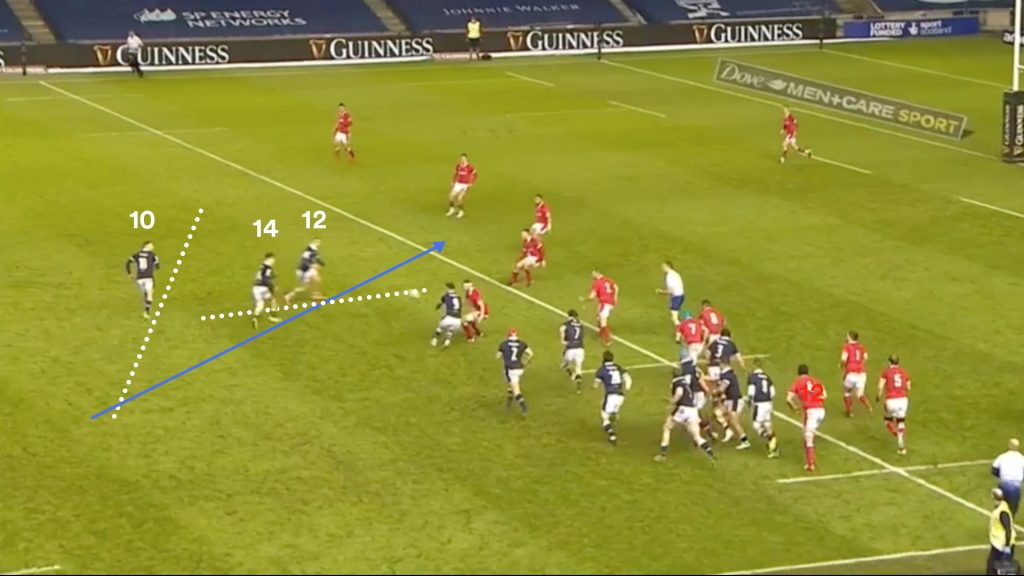
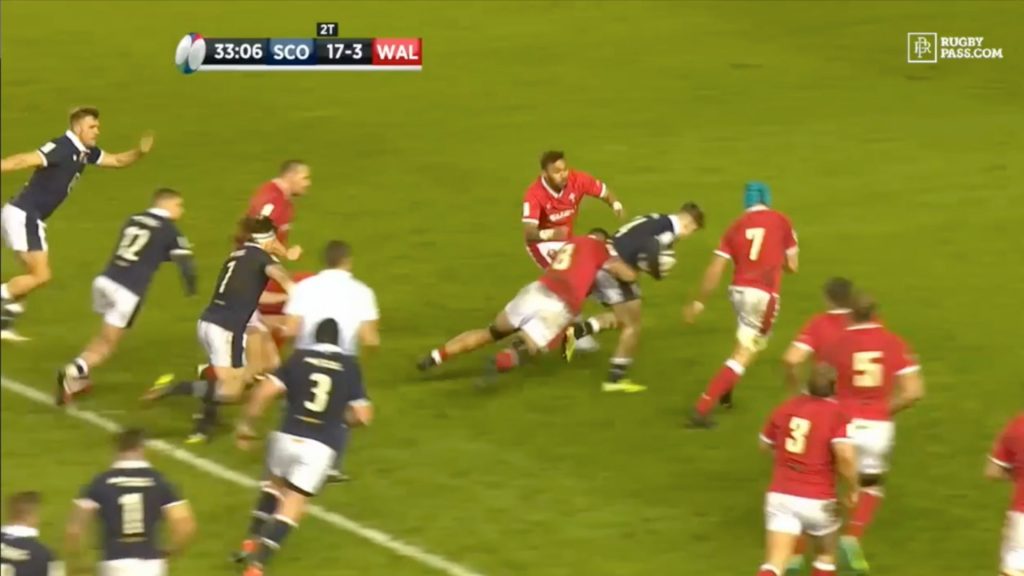
The shifty winger is able to slip past Dan Biggar and carry deep into the 22, attracting second and third would-be tacklers and setting up a great platform.
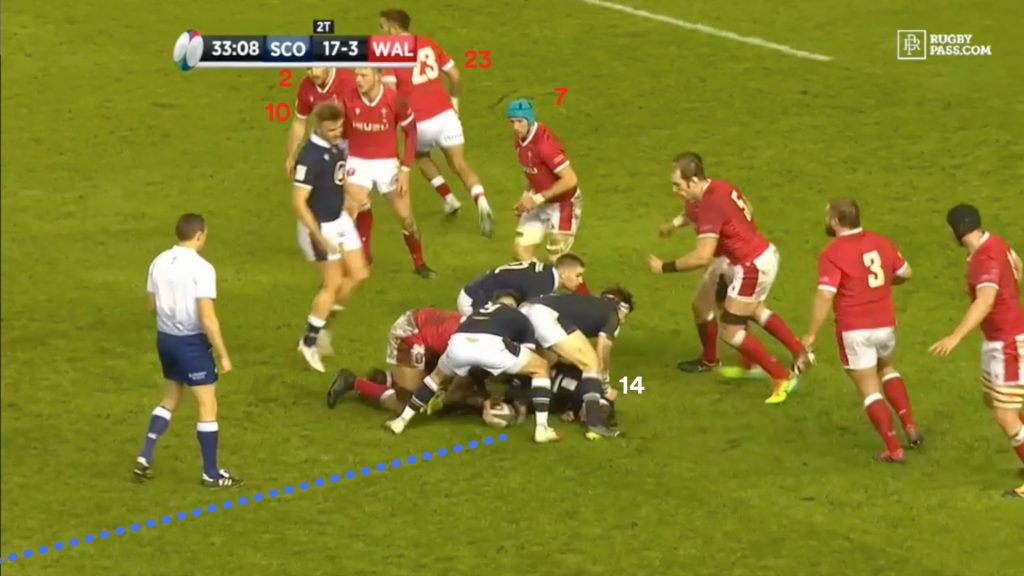
The Welsh defence is punctured, with four defenders in close proximity to the ruck and in a disorganised state. Centre Willis Halaholo (23) is circling back trying to re-form the line.
It is the perfect time for hot ball to release the backs but again Ali Price sticks with the script, playing the forwards around the corner for the carry.
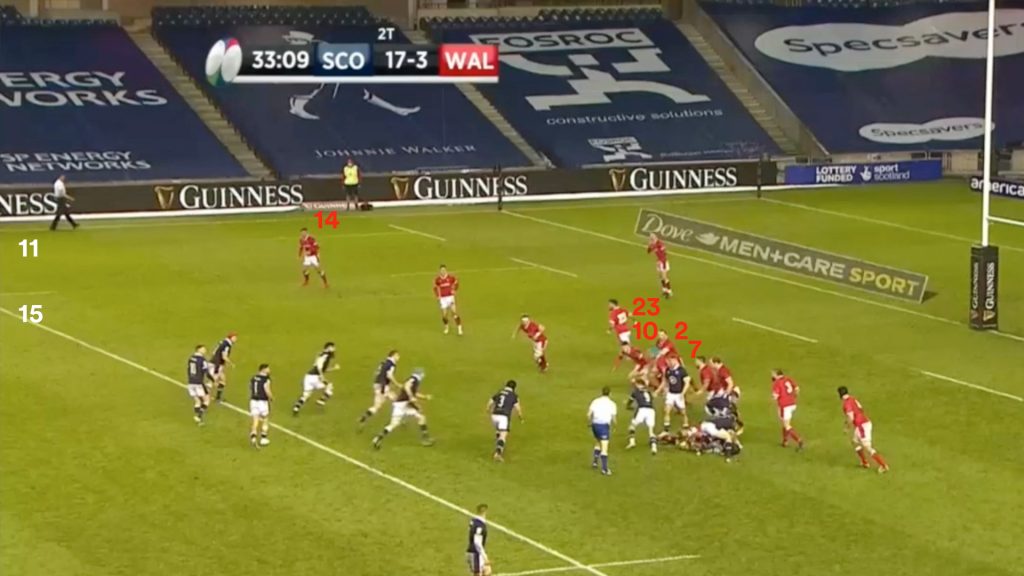
Arguably Scotland’s two most dangerous players with ball in hand, Stuart Hogg and Duhan van der Merwe, are waiting out wide looking at a weak edge defence setup.
Young wing Louis Rees-Zammit is rather isolated and would have to defend exceptionally well to shut down a wide attack on the second phase, particularly a one-on-one matchup with van der Merwe, who has proven almost impossible to put down.
It’s a matchup that needs to be taken, putting Rees-Zammit to the test.
Instead, Scotland play a switch on third phase and enter the one-out carry game, then get penalised for holding on and Wales escape what could have been the knockout punch.
Fewer than five minutes later, they strike at the other end of the park to reduce the gap to 17-8 before the break, playing with the pattern that Scotland could have utilised themselves.
From a lineout maul on the five, Wales crash it up on first phase through Halaholo, and then play to the edge through the backs on second phase and put Rees-Zammit over to score in the corner.
Scotland’s red zone inefficiency continued to falter throughout the second half, failing to capitalise on the work of Graham and van der Merwe. The first launch of the second half after a monstrous carry from Graham inched down to the goal line before obstruction rubbed out a would-be try.
It’s not until the fourth opportunity, with a set-piece scrum inside five metres after multiple penalties, that Scotland attempt to stretch Wales on the first phase.
It’s a relatively simple play that finally gives Hogg the opportunity he had been searching for – early ball from 10-metres out with defenders forced to cover wide space.

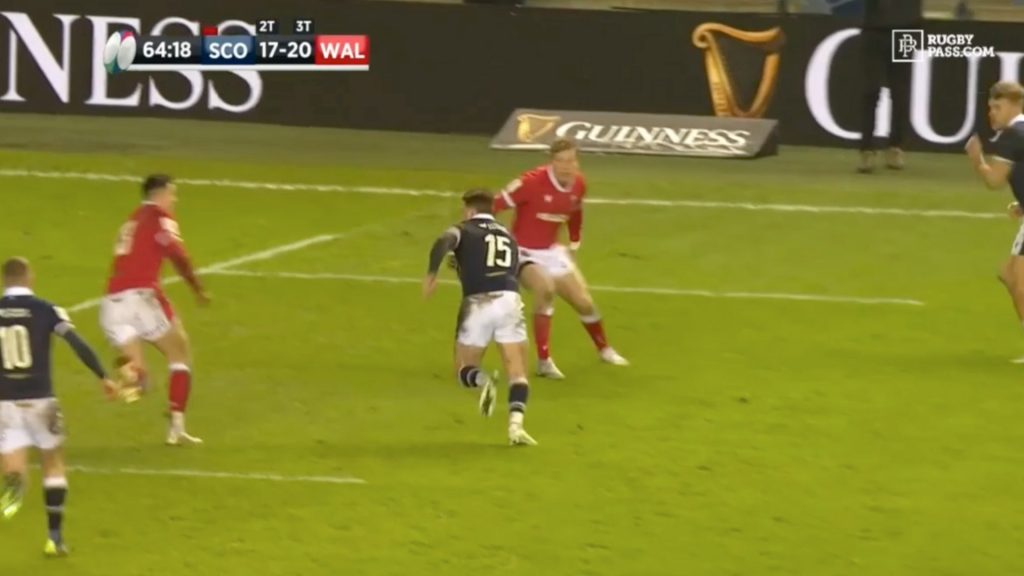
Scotland’s captain took centre Watkin on the outside, fended him off, and scored in the tackle of inside centre Tompkins, playing out on the wing.
It’s the kind of opportunity Scotland could so easily manufacture for Hogg on many of their red zone launches.
Particularly when going to the left hand side with Duhan van der Merwe outside him, the threat of Hogg from close range is amplified. The duo together could be finishing many red zone opportunities if afforded the chance.
With a flexible approach to multi-phase set-piece launch plays, Scotland can call an ‘audible’ if they inflict enough damage to the defence on the first carry in order to fire the kill shot immediately.
If the call comes in from Russell, Price must release the backs instead of slowing play down to find his designated forward runner coming around the corner. When you have a player like Hogg combining with a powerful runner like van der Merwe out wide, you must use them. Underutilising your best assets is a poor way to lose games.
The disappointing fact is, despite the incredible ball-running of Redpath, van der Merwe and Graham over the first two tests, Scotland are yet to score a try off a set-piece launch despite often biting off 5-10 metres or more on the first phase carry and pressing a side down to the 10 before doing little more and squandering away the possession.
When Scotland reviewed their loss to Wales, they would have seen that their opposition killed them using the very methods that Scotland could have adopted themselves.
Two tries, to Rees-Zammit and Liam Williams, came at close range using the width from set-piece where it’s almost impossible to defend the space camped on the goal line.
Scotland are so close to putting it altogether and have proved they aren’t far off any side in Europe.
To take it to the next level, they can’t have a sluggish red zone attack that consistently fails to score tries due to a narrow-minded, rigid approach. Some flexibility to strike while the iron is hot can add another dimension to Scotland’s game and, hopefully, help them score a few more points in the process.



Comments
Join free and tell us what you really think!
Sign up for free